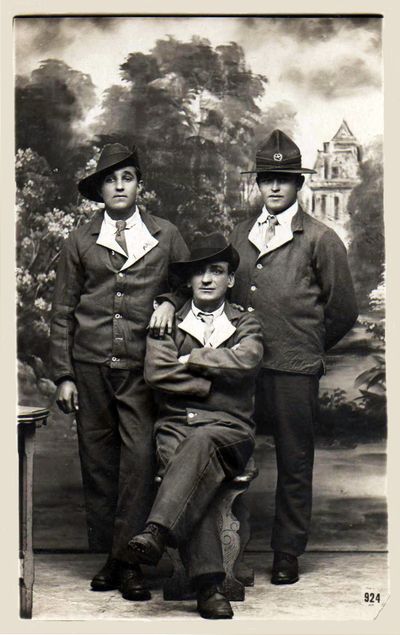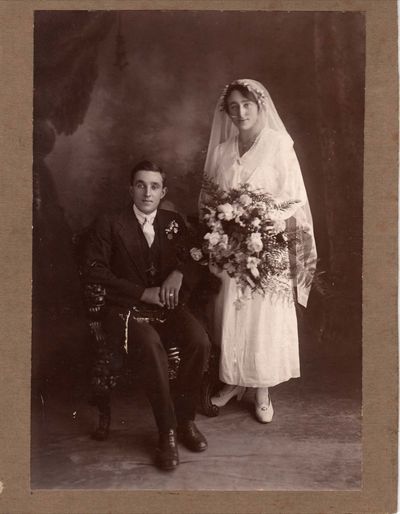Difference between revisions of "Alfred Arthur Martin"
From Our Contribution
| Line 93: | Line 93: | ||
Three days after entering camp. Alfred was allocated to the 10th reinforcement draft for the 16th Battalion. After three months training at Blackboy Hill camp he travelled with them to Egypt. | Three days after entering camp. Alfred was allocated to the 10th reinforcement draft for the 16th Battalion. After three months training at Blackboy Hill camp he travelled with them to Egypt. | ||
| − | Following more training on arrival in Egypt, he was taken on strength by the 16th Battalion on 5 Feb 1916 at Moascar, before becoming one of the initial members of the 48th Battalion on 3 Mar 1916 at Tel-el-Kebir. On 17 Mar 1916 he was seen by the 12th Australian Field Ambulance before being admitted to The 48th trained in the Serapeum area before manning front line trenches at Habieta for a brief time before embarking for France in early June. | + | Following more training on arrival in Egypt, he was taken on strength by the 16th Battalion on 5 Feb 1916 at Moascar, before becoming one of the initial members of the 48th Battalion on 3 Mar 1916 at Tel-el-Kebir. On 17 Mar 1916 he was seen by the 12th Australian Field Ambulance before being admitted to the [[2nd Australian Stationary Hospital]] later that day, rejoining his unit on 30 Mar 1916. The 48th trained in the Serapeum area before manning front line trenches at Habieta 12 miles (20 km) east of the canal for a brief time before embarking for France in early June. |
Their early experience of front line duty on the Western Front was in the "nursery area" around Fleurbaix before moving to the Somme where on 8 Aug 1916 they relieved the 27th Battalion in the trenches near the Windmill on the Bapaume road at Poziéres. During the night of 5th, and until noon on 7 Aug 1916 they suffered very heavy casualties from continuous heavy shelling by the enemy [104 killed, 418 wounded and 76 missing]. Then on the 8th they faced an enemy counter attack. | Their early experience of front line duty on the Western Front was in the "nursery area" around Fleurbaix before moving to the Somme where on 8 Aug 1916 they relieved the 27th Battalion in the trenches near the Windmill on the Bapaume road at Poziéres. During the night of 5th, and until noon on 7 Aug 1916 they suffered very heavy casualties from continuous heavy shelling by the enemy [104 killed, 418 wounded and 76 missing]. Then on the 8th they faced an enemy counter attack. | ||
| − | Having had a rest in Sausage valley during the 9th and 10th, they moved back into the front line at 6am on 12 Aug 1916 and were again heavily shelled on the 13th. This was when Alfred received his injuries - shrapnel wounds to his left thigh and right shin. | + | Having had a rest in Sausage valley during the 9th and 10th, they moved back into the front line at 6am on 12 Aug 1916 and were again heavily shelled on the 13th. This was when Alfred received his injuries - shrapnel wounds to his left thigh and right shin. Treated by the 7th Australian Field Ambulance and sent on to a casualty clearing station before being assessed for treatment options. |
| − | He was evacuated to UK on [[HMHS Panama]] from Le Havre on 18 Aug 1916, and admitted next day to 1st London General Hospital at Camberwell. Alfred was discharged | + | He was evacuated to UK on [[HMHS Panama]] from Le Havre on 18 Aug 1916, and admitted next day to 1st London General Hospital at Camberwell. Alfred was discharged from this hospital on 9 Oct 1916. While rehabilitating at 70th Battalion Wareham, Alfred had a couple of AWOL episodes, but returned to his unit in France on 3 May 1917 at Millencourt a training area west of Albert. |
| − | On 14 Jun 1917 he | + | On 14 Jun 1917 he was admitted to the 13th General Hospital in Boulogne and evacuated to England aboard the [[HMHS St David]] on 23 Jun 1917 suffering from appendicitis. Admitted to the General Military Hospital Eastern Command on 23 Jun 1917 he was released on 17 Aug 1917, and again took the opportunity to be AWOL for a short time. Alfred returned to his unit on 2 Nov 1917, and this time they were near Ypres having come from the battle for Passchendaele Ridge. |
| − | His next hospital visit, to the Southwark Military Hospital in East Dulwich | + | His next hospital visit, was via the 13th Australian Field Ambulance on 2 Feb 1918 where he was given preliminary treatment for Trench Feet. on 5 Feb 1918 he was admitted to the 8th Stationary Hospital in Wimereux before being evacuated on 12 Feb 1918 to the Southwark Military Hospital in East Dulwich. Alfred was in the [[1st Australian Auxiliary Hospital]] from 20 - 22 Mar 1918 undergoing assessment, before some furlough ahead of being reunited with the 48th Battalion on 7 Jun 1918 near the Somme River at Vecquemont between Amiens and Corbie. Thus he participated in the 1918 advance up the Somme valley. |
Discharged 5th Military District 3 Jun 1919. | Discharged 5th Military District 3 Jun 1919. | ||
Revision as of 01:24, 15 February 2018
 Alfred seated Photo courtesy Rob Richings | |
 Wedding photo Alfred and Florence Simmonds courtesy Rob Richings | |
| Personal Information | |
|---|---|
| Date of Birth | 9 Oct 1895 |
| Place of Birth | Dartford, Kent, England |
| Death | June Qtr 1972 |
| Place of Death | Hove, Sussex, England |
| Age at Enlistment | 19 years, 9 months |
| Description | 5' 6½" (1.69m) tall; weight 134 lbs (60.8 kg); dark complexion, brown eyes, dark hair |
| Occupation | butcher |
| Religion | Church of England |
| Address | Cardup via Beenup, Western Australia |
| Next of Kin | Father Mr Lewis Arthur Martin |
| Military Information | |
| Reg Number | 3141 |
| Date of Enlistment | 12 Jul 1915 |
| Rank | Private |
| Unit/Formation | 16th Battalion, 10th Reinforcement, transferred to the 48th Battalion 7 Platoon B Company / 12th Brigade, 4th Division |
| Date of Embarkation | 13 Oct 1915 - unknown at Port Suez |
| Ship Embarked On | HMAT A32 Themistocles |
| Date of Return | 28 Feb 1919 - 7 Apr 1919 |
| Ship Returned On | HMAT A68 Anchises |
| Fate |
Wounded in Action 13 Aug 1916 Mouquet Farm Returned to Australia |
| Monument |
Armadale War Memorial (Beenup panel) Armadale and Districts Roll of Honour |
| Medals |
1914-15 Star British War Medal Victory Medal |
Pre War
War Service
Three days after entering camp. Alfred was allocated to the 10th reinforcement draft for the 16th Battalion. After three months training at Blackboy Hill camp he travelled with them to Egypt.
Following more training on arrival in Egypt, he was taken on strength by the 16th Battalion on 5 Feb 1916 at Moascar, before becoming one of the initial members of the 48th Battalion on 3 Mar 1916 at Tel-el-Kebir. On 17 Mar 1916 he was seen by the 12th Australian Field Ambulance before being admitted to the 2nd Australian Stationary Hospital later that day, rejoining his unit on 30 Mar 1916. The 48th trained in the Serapeum area before manning front line trenches at Habieta 12 miles (20 km) east of the canal for a brief time before embarking for France in early June.
Their early experience of front line duty on the Western Front was in the "nursery area" around Fleurbaix before moving to the Somme where on 8 Aug 1916 they relieved the 27th Battalion in the trenches near the Windmill on the Bapaume road at Poziéres. During the night of 5th, and until noon on 7 Aug 1916 they suffered very heavy casualties from continuous heavy shelling by the enemy [104 killed, 418 wounded and 76 missing]. Then on the 8th they faced an enemy counter attack.
Having had a rest in Sausage valley during the 9th and 10th, they moved back into the front line at 6am on 12 Aug 1916 and were again heavily shelled on the 13th. This was when Alfred received his injuries - shrapnel wounds to his left thigh and right shin. Treated by the 7th Australian Field Ambulance and sent on to a casualty clearing station before being assessed for treatment options.
He was evacuated to UK on HMHS Panama from Le Havre on 18 Aug 1916, and admitted next day to 1st London General Hospital at Camberwell. Alfred was discharged from this hospital on 9 Oct 1916. While rehabilitating at 70th Battalion Wareham, Alfred had a couple of AWOL episodes, but returned to his unit in France on 3 May 1917 at Millencourt a training area west of Albert.
On 14 Jun 1917 he was admitted to the 13th General Hospital in Boulogne and evacuated to England aboard the HMHS St David on 23 Jun 1917 suffering from appendicitis. Admitted to the General Military Hospital Eastern Command on 23 Jun 1917 he was released on 17 Aug 1917, and again took the opportunity to be AWOL for a short time. Alfred returned to his unit on 2 Nov 1917, and this time they were near Ypres having come from the battle for Passchendaele Ridge.
His next hospital visit, was via the 13th Australian Field Ambulance on 2 Feb 1918 where he was given preliminary treatment for Trench Feet. on 5 Feb 1918 he was admitted to the 8th Stationary Hospital in Wimereux before being evacuated on 12 Feb 1918 to the Southwark Military Hospital in East Dulwich. Alfred was in the 1st Australian Auxiliary Hospital from 20 - 22 Mar 1918 undergoing assessment, before some furlough ahead of being reunited with the 48th Battalion on 7 Jun 1918 near the Somme River at Vecquemont between Amiens and Corbie. Thus he participated in the 1918 advance up the Somme valley.
Discharged 5th Military District 3 Jun 1919.
Alfred provided an eye witness account of the death of a fellow platoon member, Pte O. Fisher
"I saw Private Fisher hit by a shell while in the trenches at Poziéres; he was literally blown to pieces. He had some Australian sovereigns in his pocket and was just going to lend them to a friend, Private R.G. McLean, when the shell came over."In a Red Cross report Alfred is again quoted..
" A shell came over and hit the last one of four cookhouses, causing forty-two casualties. I saw Private Bole there just before the explosion and all that could be found of him afterwards was his watch, which his brother (who is in the same battalion) took. I was slightly wounded myself at the time.."
Discharged 5th Military District 3 Jun 1919.
Post War
on 21 Feb 1920 at Beenup, Alf married Florence C Simmons.
Electoral Roll entries - 1919 - 1931 Cardup, Beenup, labourer. Soon after he returned to England with Florence who was also British born.
Notes